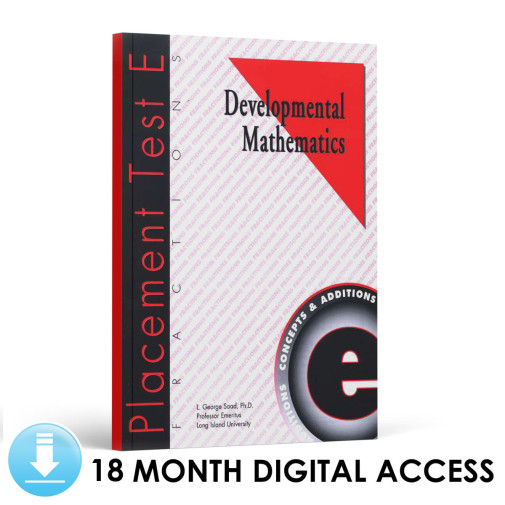We use cookies to make your experience better. To comply with the new e-Privacy directive, we need to ask for your consent to set the cookies. Learn more.
Developmental Mathematics: Placement Test E (18 Month Access)
Self-pacing and logically presented, this math program is virtually self-instructional (once your child can read). With this approach, children can progress at their own pace, according to their ability, instead of having to "put in" the requisite nine years of math before beginning higher-level math (algebra and beyond). Not only is it great for a naturally independent learner, but it would teach any child to take responsibility for his learning, and greatly improve thinking skills as well. Presentations are extremely clear, with very desirable progression of instruction from the concrete level to the abstract, then mastery through practice, and, finally, application with problem solving using word problems. Each skill is taught in bite-sized pieces and built upon slowly so as not to "lose" the child's understanding. There are no manipulatives used. Rather, pictures are substituted for live objects (this may hamper some younger or highly kinesthetic children who need to touch and feel to understand). Also, some concepts normally taught in math programs are not taught in Developmental Math because they do not really fit into the normal progression of skills. These concepts are time (including calendar time), temperature, weights and measurement. The levels are ungraded, and students should be able to complete about three levels per school year.
Each level book is divided into units, which culminate with a unit test to assure mastery. Parent guides at levels 1-9 contain general suggestions for the parent's role in the course, a brief overview of skills taught in previous levels showing the current level in context of the program, a lesson-by-lesson explanation of skills presented, and answers to exercises. Teacher guides at levels 10-16 are copies of student worktexts with answers shown. A diagnostic test is taken after students complete each level also. See individual levels for Topics covered.
Placement of your child in the program depends on his/her skill level. Students should be placed at the level of skill that they're already familiar with but have not totally mastered. If you would like more direction, Placement Tests are available in a Complete Pack or Levels. See Placement Test Descriptions for more information.
Upon completion of level 16, your child should be ready for Algebra ½ or Pre-Algebra from a more traditional publisher if wanting to transition prior to college level math courses. If this format works well for your student, Levels 17-20 are available for those ready to move on to algebra and geometry using the same format as the lower levels of this series. Students in 7th and 8th grade should have completed levels 13-16 in order to prepare for these levels which should then be done in sequence. Levels 17 and 18 are Algebra I and II, Levels 19 and 20 are Geometry I and II.
Currently available as a non-interactive eBook, families choose either a 6-, 12-, or 18-month access (up to 5 downloads are allowed). Upon purchase, an email will be sent to you directly from the publisher. Please allow 1-2 business days to receive the download. Where available, we do have limited quantities of printed worktexts, answer keys, placement tests, and the overview.
Available individually or as a set, the placement tests help you confidently place your learner in the correct levels. Individual Tests contain 8 pages, covering 3 levels. The Test Set includes all 5 Leveled Tests. Placement Test A covers Levels 2-4. Placement Test B covers Levels 5-7; Placement Test C covers Levels 8-10; Placement Test D covers 11-13; while Placement Test E assesses Levels 14-16.
| Product Format: | Other |
|---|---|
| Brand: | Mthematics Program Associates |
| Grades: | 7-8 |

